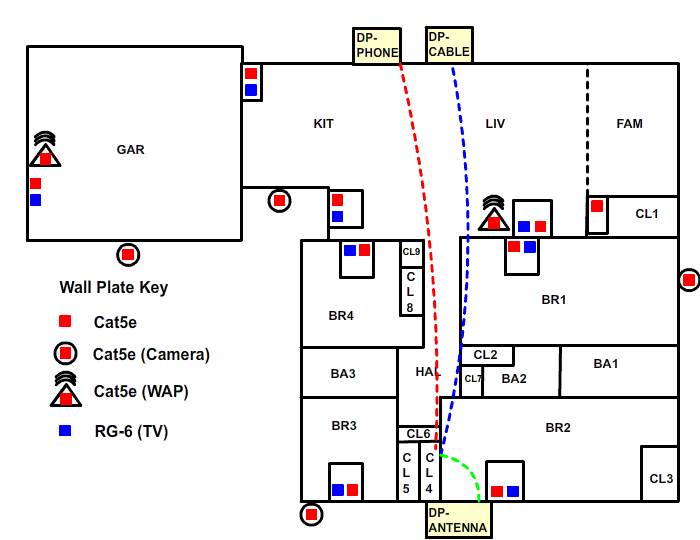
Structured Wiring Update
Intro - Updated March 2023
The XSVTOYS "Retro Structured Wiring" web pages were originally written in 2006 when that project was completed. Since that time the entire system has been in daily use and for 17+ years has operated perfectly as expected with no problems or errors. The project was a success in this regard, and over the years these web pages were returned as the #1 search result on Google for the search terms "retro structured wiring" and "retrofit structured wirings". I heard from a number of people from the internet who used the information for this project for their own setup, and upon also gave permission for the content to be used in a college class.
However I have tagged those pages with a link here because some of the information has become outdated due to advancements in technology. The physical technical details such as how things are wired and such are still pretty much the same. However there have been significant changes over those intervening years that have changed many of the ways technology is used in the home. These include:
- Vastly improved wireless networking - at the time in 2006 wireless was advancing but was still very much considered to be "second class" to a wired connection. The though process when putting the original system together was to avoid wireless as much as possible. Now wireless technology has made significant advances in speed and power and is much more useful for day-to-day use within a household. Which leads to:
- Huge increase in the use of mobile devices - smartphones were around in 2006 and advancing with RAZRs and Blackberrys being the hot items, but these were primitive compared to today's models. Also in 2006 the iPad and the idea of tablet-based mobile computing hadn't even been invented yet! Now these phones and tablets are everyday common items, and each user in a household probably has one smartphone and one or more tablets, meaning now there are multiple mobile devices that need wireless access, up to a dozen or more if guests come to visit.
- Changes in television and media consumption - in 2006 the basic model was still to get cable or satellite and get all of your television consumption that way. Now cord-cutting is the latest buzzword and there are multiple ways to get media including streaming over internet connections, which can also be done directly to the mobile phones and tablets.
- Better and cheaper TV sets- wall-mounted flat screen TVs were around in 2006 but these were expensive and still developing in quality. Now flat panels are so cheap it is no problem to hang one in every room if desired, and they also can be had bigger and with higher resolution such as 4k.
- Security camera improvements - advances in home security cameras have produced cheaper and higher-resolution cameras that can be installed on a home network with the data stored on a local DVR or to the cloud.
- Development of Internet of Things (IOT) - home voice-recognition speakers, programmable lights and thermostats, and a variety of other sensors and smart devices are becoming more common. These generally work on a wireless network system of some type.
Rethinking and revising the wiring plan
Compare a model wiring plan for 2023 on (first image below) to the original 2006 wiring diagram (second image below). The new plan offers more flexibility and coverage than the old one while requiring much less wiring which will help to reduce the expense and work of the project. The "old-school" thinking was that every room needed 2 Cat5e network ports and 2 RG-6 cable TV connections. This is overkill for today's technology. Realistically only one RG-6 cable is needed to each location where there is expected to be a TV, and each room shouldn't require more than one Cat5e network connection. (In 2023, it might not be necessary to run any coax at all). With the expanded use of wireless there probably isn't a need for any network connection in most of the rooms, although I would still put one if it is expected to contain a computer or modern gaming system to take that load off the wireless network. I would also run one network cableto the main AV system such as the TV setup in the living room, and install a small network switch there for hard-wiring in a smart TV, gaming system(s), Blu-ray players, media center, etc. In theory these could all be run from a modern wireless setup, but if the streaming of high-resolution video is sent over wires the whole setup will operate more efficiently.
The new system includes a network connection for a WAP (Wireless Access Point), these can be placed at various locations to ensure high-quality blanket wireless coverage for all of the mobile devices. While wireless security cameras can be used, for network security a wired version is better, and a single Cat5e cable can be used to both power the camera and take the signal (this requires a switch with POE (Power Over Ethernet) to be installed with the networking equipment).
Even with the addition of security cameras and a WAP compared to the original 2006 version the new 2023 version uses 8 RG-6 cables instead of 16 and 14 Cat5e network cables instead of 20. Considering that each cable drop with wall plates can cost $100-200 this means a potential savings of thousands of dollars.
Once the wiring plan is set up, most of the other details in the original XSVTOYS structured wiring pages will still apply, although there is newer hardware available.

